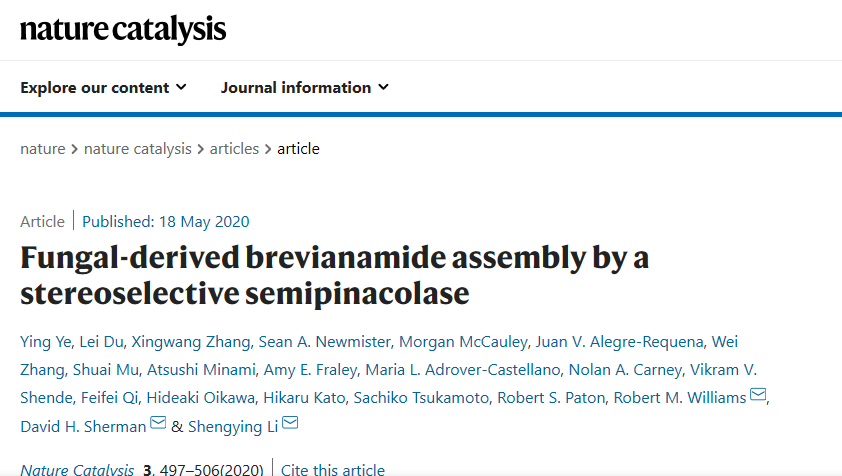
On May 18th 2020, Associate Prof. YE Ying from the School of Pharmacy, HUST made a breakthrough in the biosynthesis mechanism of the fungal alkaloid insecticidal antibiotic brevianamides, and the related research results were published online in Nature Catalysis under the title "Fungal-derived brevianamide assembly by a stereoselective semipinacolase". The research results were published online in Nature Catalysis,and Professor Ye was the first co-author of the paper.
In the past half century, fungal indole alkaloids containing bicyclo[2.2.2]diazo-octane structural units have received extensive attention in the fields of microbiology, biochemistry, natural medicinal chemistry and organic synthetic chemistry because of their diverse biological activities, unique chemical structures and mysterious biosynthetic mechanisms. Although many researchers have conducted extensive studies on the novel structure, bioactivity and biosynthesis of these natural products, and the biomimetic total synthesis of some representative compounds, such as the insecticide brevianamides, the veterinary drug paraherquamides, and the antitumor active substance notoamides, has been reported one after another, the biosynthetic mechanisms of these fungal natural products, in particular, the molecular mechanism of how microorganisms assemble to produce diastereomers and enantiomers derivatives has become the "holy grail" in the field of natural product biosynthesis
The insecticidal antibiotic brevianamides produced byPenicillium brevicompactum, the earliest member and typical representative of this class of fungal alkaloids, contains a bicyclic [2.2.2] diazo-octane structure and a rare 3-position spiro-indole backbone in its structure. Half a century ago, Sammeset al.first proposed the hypothesis that the bicyclic [2.2.2] diazo-octane moiety might be produced by the [4+2] Diels-Alder cycloaddition (DA reaction), but this hypothesis has long lacked direct biochemical evidence and become a famous "unsolved case" in the field of biosynthesis. ".
This paper is the first in the world to reveal the stereoselective synthesis mechanism of brevianamide A fromPenicillium brevicompactumby application of microbial genetics, functional genomics, biochemistry, synthetic chemistry, structural biology and quantum chemical computation, and successfully solved this "unsolved" case: it was found that BvnD, a cytochrome P450 monooxygenase, catalyzes the desaturation of the C-N bond in the diketopiperazine ring to provide the necessary diene for the DA reaction, and BvnE, an isomerase, catalyzes the semipinacol rearrangement to selectively produce the DA precursor. The isomerase BvnE catalyzes a semipinacol rearrangement that selectively generates DA reaction precursors and leads to the diastereoselective synthesis of the 3-positioned spiroindole backbone, which ultimately generates brevianamide A and B through a spontaneous intramolecular DA reaction (IMDA).
The above results not only enrich the mechanistic understanding of complex chiral ring-forming reactions catalyzed by fungal biosynthetic enzymes, but also lay the theoretical foundation for the creation of more structural derivatives of active indole alkaloids using combinatorial biosynthesis and synthetic biotechnology in the future, which are of great socio-economic importance for the development of new biopesticides, veterinary drugs or human drugs.
Prof. Shengying Li, State Key Laboratory of Microbial Technology, Shandong University, Prof. David Sherman, University of Michigan, and Robert Williams, Colorado State University, are the co-corresponding authors of this paper. Lei Du, a member of Prof. Shengying Li's group, is the co-first author.
Associate Professor Ying Ye graduated from Hokkaido University, Japan, under the supervision of Professor Hideaki Oikawa, a well-known expert in the field of fungal natural product biosynthesis, and then worked as a postdoctoral researcher in the laboratory of Professor David Sherman, a renowned expert in the field of natural products at the University of Michigan, U.S.A., mainly engaged in microbial/fungal natural medicinal chemistry and biosynthesis. In 2019, through the special overseas recruitment session of Huazhong University of Science and Technology, she joined HUST and started working in Hubei Key Laboratory of Natural Medicinal Chemistry and Resource Evaluation, College of Pharmacy.
